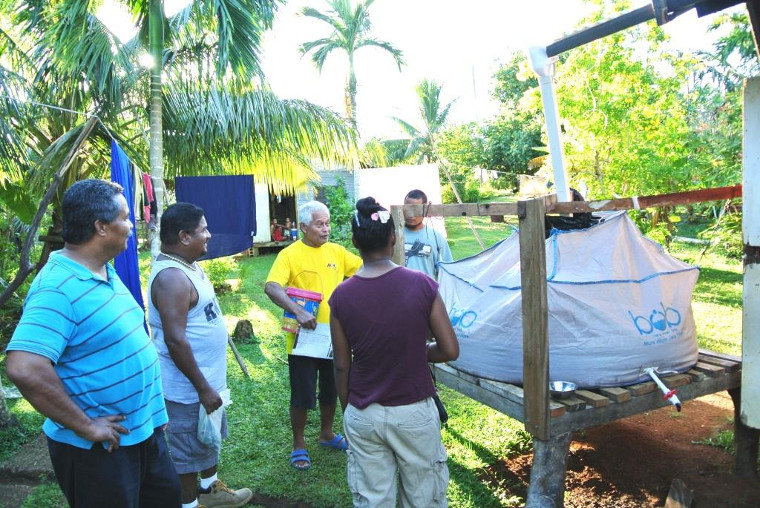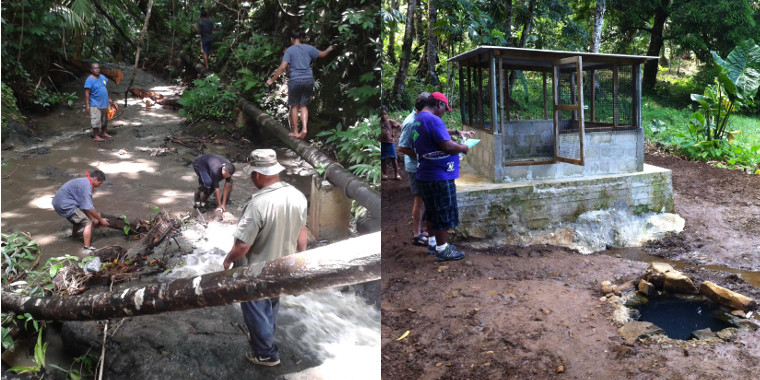Water for Life
On remote Pacific islands, water insecurity is growing. More frequent and severe floods and droughts, rising sea levels, and development threaten already limited potable water supplies. In response, Water for Life (WfL; NSF AISL award 1224185) is building communities’ water literacy while improving their access to high quality drinking water. Organized and run through Pacific Resources for Education and Learning (PREL), WfL melds engaging and relevant informal science education with powerful professional and community service learning components in the Marshall Islands, Palau, and Chuuk and Yap States in the Federated States of Micronesia.
Residents of small islands have always been acutely aware of drinking water as a valuable resource. As just one example, the Hawaiian word for water is “wai” and that for wealth is “waiwai," highlighting the understanding of the vital role of water. Islanders have traditionally been excellent at ‘reading’ cloud and weather conditions, knowing which brings rain. In these senses, Pacific Islanders have always been highly water literate.
Recognizing that local expertise in these remote islands would be critical to project success, WfL leaders assembled Core Teams at each site to prioritize, plan, implement, and evaluate local projects. PREL staff and key collaborator Island Research and Education Initiative (IREI) identified and recruited leaders from the education, water resource, and environmental communities at each site.
Core Teams spent much of the first year organizing, and developing their capacities to plan and carry out cross-sector local projects. Despite proposed plans to simply build or renovate rainwater catchment systems (RWCSs), the four local Core Teams each recommended a different approach. Through these and other regional infrastructure projects, thousands of residents now enjoy the benefits of more, higher quality water.
- In Chuuk, WfL focused on improving groundwater springs to enhance access to high quality drinking water. Two springs now have cement catchment basins, screening, and covers to minimize contamination, and their water is being piped to publicaly accessible taps. And a Chuukese billboard promotes protection of streams from pollution.
- In Palau, WfL has helped communities revitalize surface water catchments by planting vegetation, repairing dykes and dams, clearing trash from stream beds, dredging mud, etc. WfL leaders have worked with teachers to create engaging out-of-classroom science-learning experiences on water for middle school students and new chemistry units on water for high school students.
- In the Marshall Islands, driven by an accreditation mandate to provide clean drinking water for students, all 12 public schools on Majuro have upgraded their existing RWCSs with WfL assistance, cleaning tanks, fixing gutters, repairing leaks, and installing screens and first-flush diverters. Trained by local EPA staff, school-based teams of teachers, parents, and students now regularly inspect and maintain their RWCSs and monitor water quality.
- In Yap, the Core Team focused on improving quality of captured/stored rainwater through the installation of first-flush diverters in RWCSs. On both Yap Proper and Ulithi, these devices – that separate the initial wash off roofs, keeping contaminants out of the main catchment tank – are now providing higher quality drinking water in community centers, churches, schools, and homes.
Local workshops help residents learn to maintain and monitor the quality of water. Educational signage in local languages is being installed so that all WfL ‘infrastructure’ projects also become venues for informal science learning. WfL staff in each site collaborate with other agencies to promote water conservation and stewardship in events such as World Water Day and Earth Day. To further raise awareness of water issues, 750 laminated posters highlighting key messages of maintaining quality and quantity of water have been distributed around the region. Other water learning resources include a pamphlet describing the water cycle on tropical islands, a booklet on freshwater resources across Micronesia, and six modules (about 50 pages each) covering the breadth of water-related science. These, and other educational materials are available on the project website and in hard copy format.
3,000 copies of the new Water for Life: Handbook for Education, Health, and Community Resilience are being distributed across the region. Day-long workshops help teachers and community educators learn how to use this new resource in effective ways for diverse audiences.

Changes in individuals’ and communities’ behaviors around water are clearly occurring; for example, first flush diverters are becoming more widely used in Yap. Schools now recognize the need to provide clean drinking water for their students across Majuro. Leveraging recent events such as the El Nino-associated drought is a good way to highlight the importance and rationale for our project among the broader population.
Beyond these projects and educational materials, one of the unanticipated outcomes of Water for Life is how this work has nurtured collaborations among the diverse education, water, and environmental stakeholder groups. In each site, such alliances have spurred joint projects that are improving access to clean water while building communities’ science literacy.
Patience and persistence are key virtues required to conduct this work. "Buy in” from community leaders is crucial, and power structures are not always evident. Having local staff, people who actually live and work on site, is critical to accomplishing anything, as these are the people who will know to whom you must go for approval, how to move projects ahead most efficiently, and what local resources are available.
Three big ‘take home' messages of the project have been:
- Listen, so that topics and approaches are responsive to community needs.
- Work within the cultural context in order to create an effective intervention.
- Engage local leaders and a broad spectrum of stakeholders to build a collective impact approach.
The project has faced daunting challenges including the need to travel long distances, address project messages in local languages and cultures, and deal with unreliable internet connections The four sites span 2,500 miles, with the nearest being 2,300 miles from PREL’s base in Honolulu. Each site includes numerous smaller islands, and many are hundreds of miles from the main site, thus travel for the project is time-consuming and expensive. While English is spoken across the region, residents are more comfortable in their local and regional languages and dialects, for example Marshallese, Chuukese, Yapese, and Palauan in these respective sites.The linguistic diversity complicates the communication of project messages as each site and region requires translations that account for local language preferences and cultural norms. These norms are place-specific --gender roles and social stratification to name two examples. Another challenge lies in the after-effects of colonialism that persist, e.g. RWCSs that were built many years ago often haven’t been cleaned or repaired since.
Like all other aspects of this project, evaluation has also been informed by the cultures where the work is taking place. It is a cultural norm for Micronesean’s to be self-deprecating, so many tend not to speak about themselves and what they’ve accomplished. Hence one can find out more about someone by asking their friends and colleagues about what they’ve done. Thus self-report surveys are difficult and not always revealing - besides being difficult to administer in any large scale, online format. Project evaluators David Heil & Associates (DHA) have had to employ resourceful and creative processes to meet these challenges. From early formative surveys, to documenting diverse products and activities, to designing rubrics for prioritizing local projects, DHA has crafted responsive processes and instruments that are attuned to local needs and constraints.

Water for Life plans to continue to expand its work. A supplemental award from NSF has funded the creation of a ‘maker space’ project where high school students are creating products and processes that use locally abundant solar energy and saltwater to address limited freshwater and food production capacities. Other future plans include activities that will build on evaluation findings to further broaden and deepen the regional capabilities for building water literacy, security, and self-sustainability.